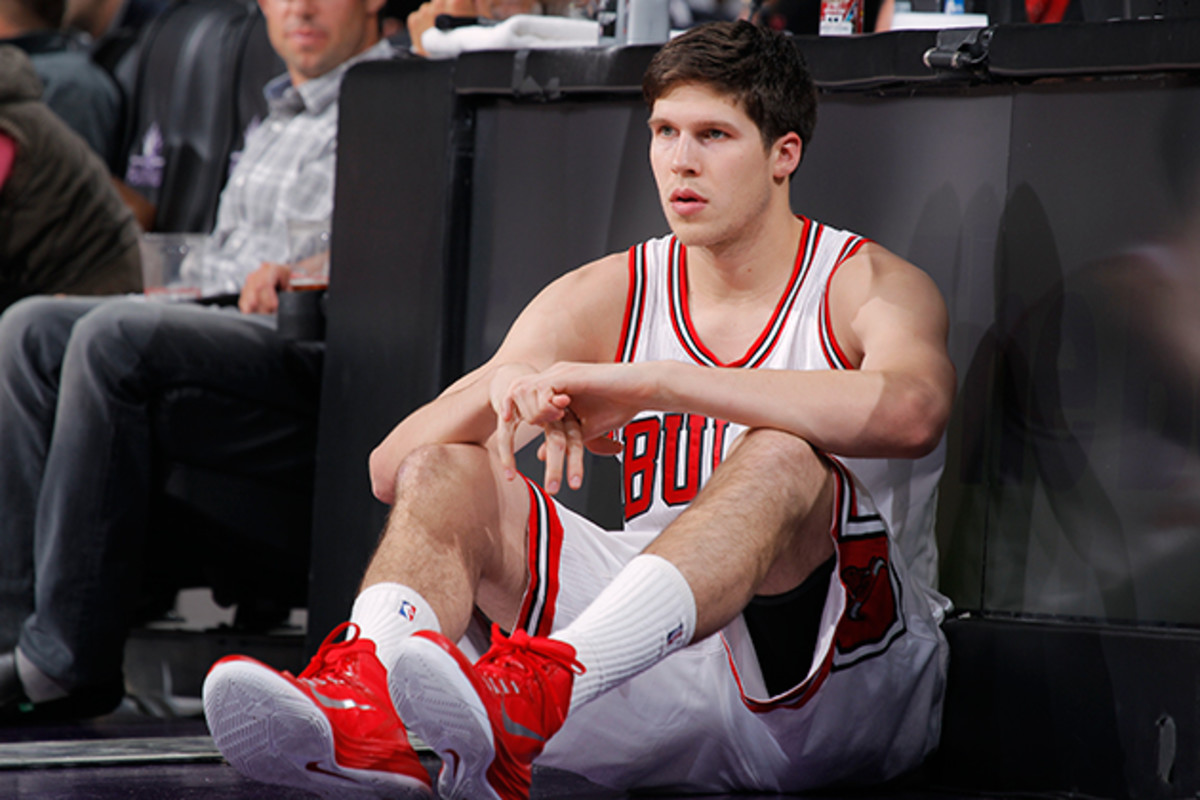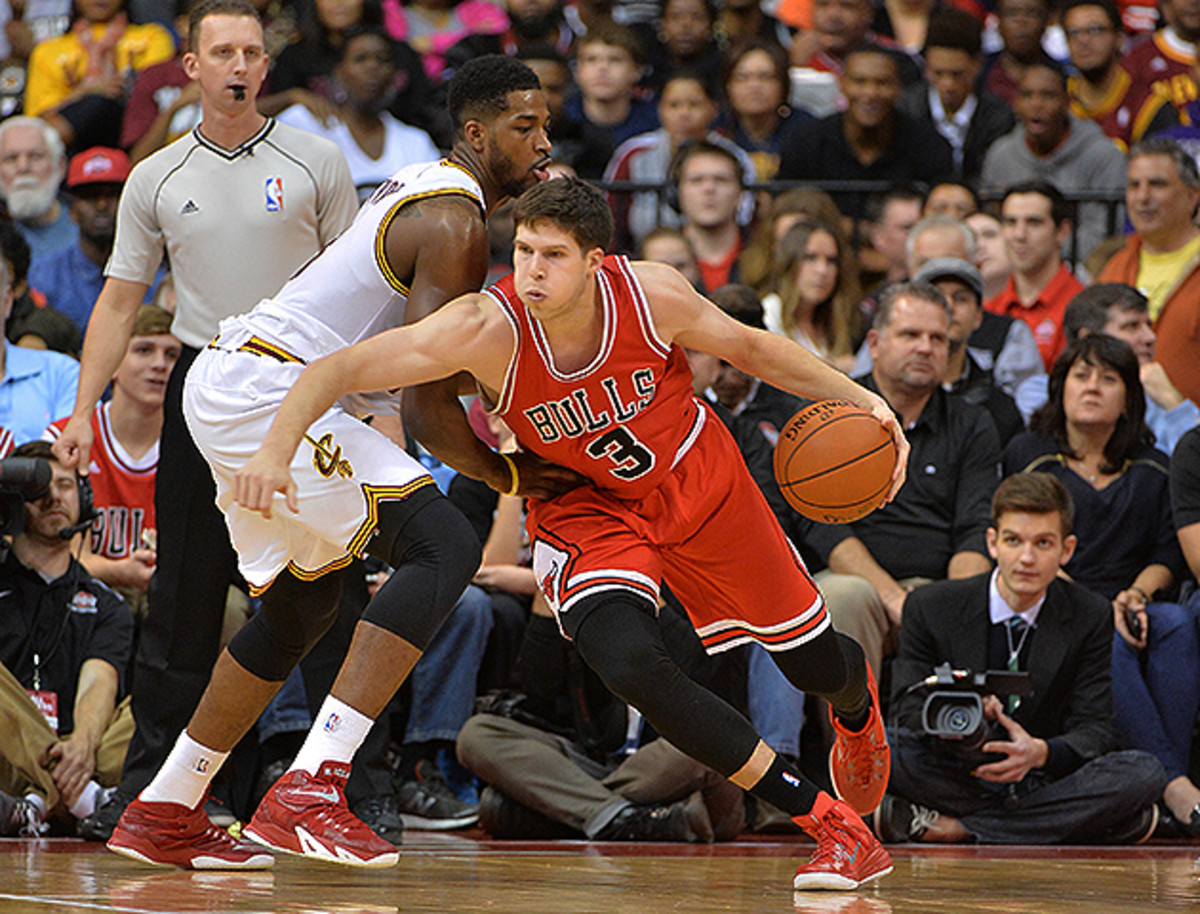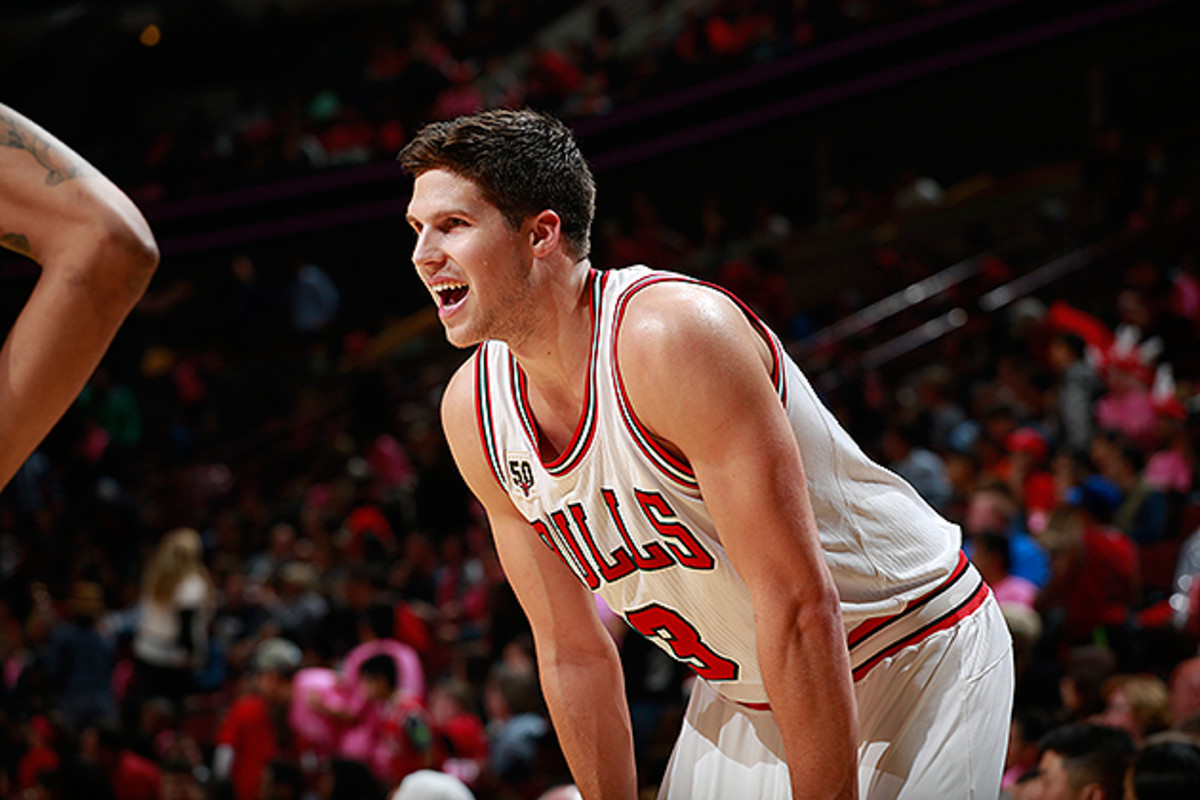Doug McDermott showing signs of NBA potential in Bulls' new system

No one has ever doubted Doug McDermott’s ability to shoot. The Bulls certainly didn’t when they traded away two picks to nab him in the 2014 NBA Draft, a year removed from finishing dead last in points per game (93.7). Since finding a regular spot in the Bulls’ rotation, he’s shown more of the dead eye shooting that won him the National College Player of the Year award at Creighton, and is starting to justify the high draft pick–even though it may have taken some time.
Entering Thursday, McDermott is second in the NBA in 3-point shooting percentage, having made 30 of his 63 attempts, and has shouldered the shooting load for the injured Mike Dunleavy and the struggling Nikola Mirotic. He’s been lethal on the wing, and has been knocking down shots with miniscule amounts of space. He’s been effective both in transition as well as coming off screens, and new head coach Fred Hoiberg seems intent on getting him open in whatever way possible.
Let’s do a blind comparison between McDermott and a former Bull. McDermott is scoring 9.4 points per game, logging 22.2 minutes per game on the floor and shooting 47.6% from deep on 3.3 attempts per game. Player B, the former Bull, averaged 8.3 PPG, played 20.1 minutes a game and shot 43.4% from three-point range on 3.5 attempts during his best season in Chicago.
First-Quarter NBA Awards: Warriors, Stephen Curry stand ahead of pack
is 6’7” while McDermott is 6’8”), they have a similar shooting stroke and they even sport the same haircut.
Now, Korver was a better overall player, and Thibodeau used him differently; his quickness and athleticism allowed him to run the baseline and get open at a consistent rate, whereas McDermott is more stagnant and has to rely more on spacing. But Korver was entering his prime in 2011. McDermott is only in his second year, and has already matched those shooting numbers (although his percentage has dropped in recent games). It’s not outlandish to think that with a few more years of improvement, McDermott can develop into one of the premier 3-point shooters in the NBA—just like he was in college.
The NBA didn’t exactly come easy for McDermott out of the gate. After scoring 12 points in Chicago’s season opener and showing flashes early, he shot poorly throughout the month of November and eventually went down with a knee injury in December, the first major injury of his basketball career. When he returned from arthroscopic knee surgery, his struggles continued, and he finished the season averaging 3.0 PPG on 40.2% shooting–not exactly numbers you’d expect from the fifth all-time leading scorer in NCAA history. Some questioned the lack of fit in Thibodeau’s system, and others went as far as to label him as a bust.

“Obviously Doug had a very decorated college career, so the expectations for him were off the charts,” says Greg McDermott, Doug’s father and former coach at Creighton. “Had he not gotten hurt, maybe it would have turned out different.”
When you take a closer look, however, McDermott’s rookie struggles weren’t so much a result of performance rather than opportunity. The 2014 Bulls weren’t the 76ers; they were a deep team with veterans at every position, and a coach that was infamous for keeping his key players on the floor for extended minutes (Jimmy Butler led the NBA with a staggering 38.7 minutes per game last season). McDermott was only averaging just above ten minutes a game before his injury, which is nothing new for rookies under Thibodeau. So while fans might have liked to see him fire away like he did in college, the coaching staff was much more focused on playing for a title than giving their rookie big minutes.
LeBron's Time: Cavaliers star feeling the urgency to bring title to Cleveland
] has been historically tough on rookies, I knew that coming in. Guys like Jimmy Butler, he didn’t really play at all his rookie year, and now look at him.”
Butler averaged 2.6 points per game in 8.5 minutes his rookie season–very similar to McDermott’s stats. First round pick Tony Snell averaged almost double the minutes during his first year (albeit in a season ravaged by Bulls injuries), but only logged 4.5 points per contest. Both have turned into starters, and have made significant strides in each of their first years as a pro.
In McDermott’s second year, he seems to be following suit. The signs of improvement were visible as early as Summer League play, when he averaged 18.8 points per game on 48% shooting and made the All-Summer League First Team. Those numbers actually weren’t far off from McDermott's Summer League output in 2014, when he averaged 18.0 points on 44% shooting, but a key difference came from the guy standing on the sideline. Fred Hoiberg, the Bulls’ newly hired head coach, was one of the few full-time head coaches to actually run the summer league squad, and it allowed the two to develop a working relationship.

in Summer League was huge for me, getting familiar with him and his assistants,” says McDermott. “I felt like I kind of had a head start going into training camp, which I definitely needed. Going into your second year, you know what to expect a little bit more.”
The second time around, McDermott was able to parlay his success into the regular season, and as his minutes have doubled in his sophomore year, his points have nearly tripled. And there’s no doubt that some of McDermott’s success is due to the new regime in Chicago. Hoiberg and McDermott had a number of ties before they both joined the Bulls; they both went to Ames High School in Ames, Iowa (with Hoiberg preceding McDermott by 20 years), and Hoiberg also replaced Doug’s father as head coach for Iowa State when Greg left for Creighton. A ten-year NBA veteran as a player, Hoiberg was also a three-point specialist during his career, and has a special appreciation for shooters that some believe the former Bulls regime didn’t have.
Open Floor: Is it possible to compare Kristaps Porzingis to Dirk Nowitzki?
“The way Fred played, and the way he coached at Iowa State, he values guys who can shoot the basketball and score the basketball,” Greg McDermott says. “He has tremendous confidence in Doug, and any player would appreciate that. I think Doug certainly does.”
But if you ask Doug, there’s nothing magic about Hoiberg’s offensive system that all of a sudden turned him into a better player. This is, apart from Bobby Portis and Cristiano Felicio (who have logged a combined 26 minutes so far in 2015), the same roster as last year under Thibodeau. Although Hoiberg emphasizes more movement and spacing on the offensive end, their 98.9 PPG through 19 games is down from their 100.8 in 2014-15, and their offensive efficiency is significantly worse, No. 27 in the NBA compared to No. 10. (Interestingly, their defensive efficiency is better than it was last season—No. 4 in the league.)
“Not a whole lot has changed this season, except for me playing more,” McDermott says. “With last year, people can come at my confidence, they can come at how well I played all they want, but the reality was that I just wasn’t really playing. This year, I’ve just gotten more minutes, and I feel like I’m producing more because I’m getting more shots. In order to play good basketball, you have to be out there.”
The downside of McDermott’s increased usage is that the extra playing time has given light to his true weakness: defense. His net rating sits at -7.3, by far the worst number on the Bulls, which is astounding considering he’s making nearly half of his shots. The eye test hasn’t been forgiving, either; he’s consistently struggling to switch on defenders, and appears to lack the athleticism to defend on the perimeter, where he has logged most of his minutes.

returns, McDermott will likely be required to do less on defense. That will allow him to focus more on doing what he does best—shooting the basketball.
“Doug mostly played a stretch-4 in college, and because we needed him on the floor from an offensive standpoint, I was going to make sure I protected him defensively,” his father said. “He’s been put in a few different situations than he had been in college. If he gets a little stronger down the road, he can play some stretch-4 in the NBA, but obviously with the depth the Bulls have at that position, that’s probably not in the cards right now.”
The first few games of the Fred Hoiberg era have gone better than some expected, with the Bulls sitting at 11–8. But the team is, in many ways, still a work in progress. Hoiberg inherited a lot of talent, but the challenge comes in fitting the pieces together and working out a rotation that maximizes everyone’s strengths. And through sixteen games, McDermott has shown that he can shoot the basketball as well as anyone on his team, and has done nearly a better Kyle Korver impression than Korver himself. That strength alone is sure to earn him a consistent role going forward—and he’s got plenty of time left to improve the rest of his game.
“This is pretty much a rookie year for me, since I didn’t get to see the floor a lot last year,” McDermott says. “Rome wasn’t built in one day. I’m still learning, and I’m just going to continue to fight. I feel like I’m improving already, but we’re only a few games in, and I just need to continue to work.”
